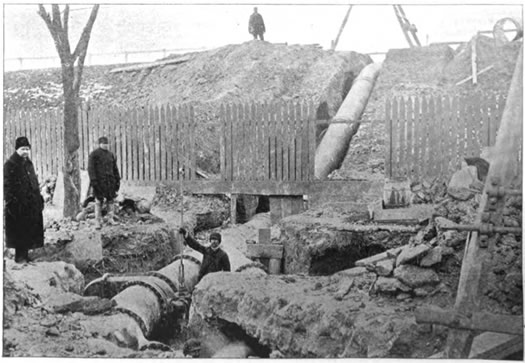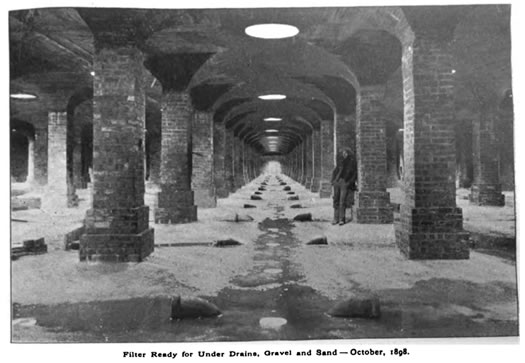Cast iron and hollowed-out tree trunks

A water main being constructed at the former Bleecker Reservoir in Albany around 1898. (The reservoir would later be converted to Bleecker Stadium.)
Reading this recent NPR segment -- about the 200- or 300-year replacement cycles for water mains in some cities -- got us curious about Albany's water mains. And that led us to this bit from the Albany water department (emphasis added):
Fifty-five miles of Albany's 376 miles of water mains were installed in the mid-19th Century. However, some of the mains may even be older, with some cast iron mains possibly installed in 1813. If true, Albany would have the oldest functioning cast iron pipe in the western hemisphere. Incidentally, all of the water mains in the City originally were hollowed-out tree trunks, many installed in the 1700's. Although unlikely, there is a very remote outside chance that somewhere beneath some of the oldest parts of our City, a functioning wooden water main remains.
Yep, hollowed-out tree trunks (see: a 19th century overview of how that worked). And about 15 percent of Albany's water mains are at least 150 years old.
That a good chunk of the city's water infrastructure stretches back a century-and-a-half makes sense. It was around 1850 that the city started the planning on what would be the foundation of its modern water system.
At the time Albany had been served by the private Albany Waterworks Company, which had its own network of iron (and wooden) pipes and reservoirs. But the city was growing rapidly -- Albany's population was around 5,000 in 1800, it hit roughly 50,000 in 1850, and it would rise to almost 95,000 by 1900. And leaders were looking for a more robust and reliable supply of water.
So the city hired William J. McAlpine, a prominent civil engineer, to study how to expand the city's water supply. You can read his 1850 report online -- if you're into local history or urban planning or engineering, it'll be interesting to you. McAlpine laid out a range of options, some of which included drawing on the Patroon Creek. The city ended up damming the creek, forming Rensselaer Lake and the Six Mile Waterworks (because it's six miles from Albany City Hall). And Albany got a municipal water system -- a system that would cover roughly 23 miles of streets, by McAlpine's estimates.

Pumping equipment in the Albany Pump Station, sometime around 1898.
As it happens, the city later pursued another option outlined by McAlpine: pumping water from the Hudson River. You know the Pump Station building in downtown Albany -- the site of the brew pub of the same name? That building was originally constructed in the 1870s to pump water from the Hudson up to the Bleecker Reservoir (which was later converted to Bleecker Stadium) in West Hill.

Along the way, Albany was an earlier adopter of what was then modern drinking water system tech. It was the first city in the US to use a slow sand filter. And it was among the first to use chlorination during the first part of the 20th century.
The use of chlorine ended up playing a key role in the flood of 1913, which inundated the Pump Station -- and, as a result, contaminated a large portion of the city's drinking water supply. From a very interesting account of the situation by Trudy E. Bell:
Despite everyone's fast action, when the State Department of Health samples water in the two hilltop reservoirs (to which the filtration plant pumped pure water for gravity-fed distribution to the city), they find B. coli (an animal fecal protozoan that was an indication of contamination by sewage) in Prospect Reservoir, which served half of Albany. But the gate valve--which can shut off the reservoir from the water-distribution system--is stuck open! There is no way to prevent sewage-contaminated water from pouring out the taps in half of Albany's homes!
Desperate times call for desperate measures. Engineers load a small boat with bags of hypochlorite of lime, row out into the center of the reservoir, punch holes in the bags, and shake them vigorously as they continue rowing around and across the lake, releasing the bleach powder directly into the water. (No report mentions whether Prospect Reservoir was lined with trees and vegetation or populated with fish, or the effects on the environment from adding concentrated bleach directly to the reservoir.) Just to make sure, they sterilize the reservoir a second time a few days later.
Typhoid broke out shortly after the flood, and a researcher with the state Department of Health -- Theodore Horton -- linked the outbreak to the flooded pumping plant. His study of the series of events ended serving as a public health case study.
By the 1930s, neither the Pump Station nor the Six Mile Waterworks was still involved in the city's water system. Albany had switched its supply to the Alcove Reservoir in Coeymans, which had been created in the late 1920s by damming the Hannacroix Creek. It's the city's current water supply.
Infrastructure like the water system can be easy to forget about. And that's almost by design -- it's working if you don't have to think about it. But it's one of the things that makes a city possible. And it's kind of amazing that a system with parts that are a century and a half old is still supporting Albany today.
(NPR link via @Andy Arthur. Thanks to the Villanova University's Falvey Memorial Library for the research help.)
Bonus link: A history of the Troy water supply
images: Annual Report of the Water Commissioners of the City of Albany, Volume 48, Parts 1898-1907 via Google Books
Say Something!
We'd really like you to take part in the conversation here at All Over Albany. But we do have a few rules here. Don't worry, they're easy. The first: be kind. The second: treat everyone else with the same respect you'd like to see in return. Cool? Great, post away. Comments are moderated so it might take a little while for your comment to show up. Thanks for being patient.
Comments
John Taylor, arguably the most significant brewer in Albany's beery past was alo one of the city's first water commisioners--among a few other members--in 1850. He and his cronies were instrumental in establishing Albany's modern water infrastructure.
... said Craig on Aug 11, 2014 at 6:56 PM | link
My uncle was the water and sewer commissioner in Schenectady in the 80s and has told me that at least once they found a hollowed out tree trunk when replacing water mains.
... said Aaron on Aug 12, 2014 at 8:20 AM | link
Don't know of any wooden joints but I heard about one or two lead/oakum joints that were removed as part of a construction project a few years back. They insisted on removing them back to the street because of the lead even though there's probably a hundred that the water has travelled through to get to that point. Since the water doesn't likely sit long in the pipes/joints there's probably not a lot getting into the water but I'm happy to not be drinking city water.
... said Cheryl on Aug 12, 2014 at 8:26 AM | link